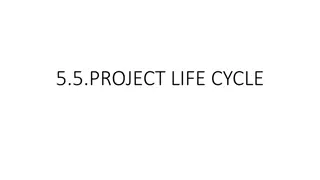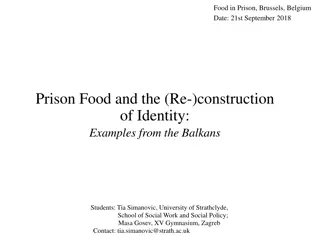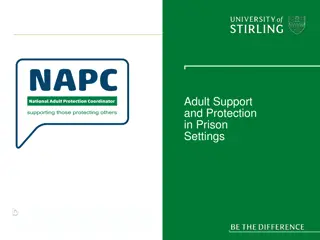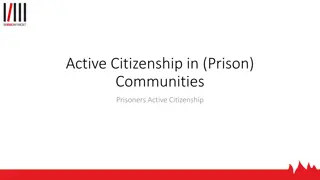Research on Prison Conditions, Normalisation, Wellbeing, and Nature Contact
Research projects led by Dominique Moran at the University of Birmingham focus on prison conditions, normalisation, wellbeing, and the impact of nature contact on prisoners. The studies explore the architecture, design, and technology of carceral spaces in the UK and Scandinavia, examining how these spaces reflect societal goals and approaches towards rehabilitation. The projects aim to understand the lived experiences of individuals in prisons, emphasizing the importance of nature contact for prisoners' wellbeing.
Download Presentation

Please find below an Image/Link to download the presentation.
The content on the website is provided AS IS for your information and personal use only. It may not be sold, licensed, or shared on other websites without obtaining consent from the author.If you encounter any issues during the download, it is possible that the publisher has removed the file from their server.
You are allowed to download the files provided on this website for personal or commercial use, subject to the condition that they are used lawfully. All files are the property of their respective owners.
The content on the website is provided AS IS for your information and personal use only. It may not be sold, licensed, or shared on other websites without obtaining consent from the author.
E N D
Presentation Transcript
PRISON CONDITIONS: Dominique Moran University of Birmingham @drdommoran NORMALISATION, WELLBEING AND CONTACT WITH NATURE
PRISON CONDITIONS: NORMALISATION, WELLBEING AND CONTACT WITH NATURE Projects Prison conditions Normalisation inside and outside Wellbeing and Attention Restoration Theory Effects of nature contact
PROJECTS: Prison architecture, design and technology and the lived experience of carceral spaces. o 3.5 year ESRC project with Yvonne Jewkes, Jennifer Turner and Ellie Slee o Why do we build prisons as we do (in the UK and Scandinavia)? o (How) Do they communicate punitive philosophies? o How are they experienced by those who live and work in them? Attention Restoration Theory and nature contact in prison o 6-month ESRC IAA impact project o What difference does nature contact make to prisoners wellbeing? o How effective is ART for understanding the effect of nature contact in prison?
PROJECT: PRISON ARCHITECTURE, DESIGN AND TECHNOLOGY AND THE LIVED EXPERIENCE OF CARCERAL SPACES. The design of a jail or prison is critically related to the philosophy of the institution, or maybe even of the entire criminal justice system. It is the physical manifestation of a society s goals and approaches for dealing with arrested and/or convicted men and women, and it is a stage for acting out plans and programs for their addressing their future Wener (2012: 7)
PROJECT: PRISON ARCHITECTURE, DESIGN AND TECHNOLOGY AND THE LIVED EXPERIENCE OF CARCERAL SPACES. Data generation at HMP Grampian, UK; Halden, Norway, and with prison architects, construction engineers etc. in Norway, Denmark, Spain, UK, etc. Contrasting (and changing) policy context England and Wales (arguably ) moving from punitive towards rehabilitative Nordic region (arguably ) steeped in normalisation and humane principles of confinement
PRISON CONDITIONS 83-84,000 prisoners in England and Wales (79,000 male, 4,000 female) System runs very close to capacity (of 85,616). Approximately half live in crowded conditions (i.e. two in a space designed for one) c117 establishments, with populations ranging from 1-200, to over 1500 Prison estate varies in age, from Victorian (e.g. HMP Birmingham, Leicester) to under- construction However, across the estate, environments are fairly similar, in part due to security and technical standards driving construction of standardised accommodation. Long-term concerns for living standards recent media attention drawn to poor HMIP inspection reports, noting dilapidation, infestation, mould, poor sanitary conditions, etc.
PRISON CONDITIONS Noisy prisons are live spaces where noise reverberates off hard, reflective surfaces. There is overly-bright, hard- edged sound, with excessive echoes. Noise sources include constantly bleeping alarms, clanging gates, rattling keys, and lots of shouting. HMP Altcourse
PRISON CONDITIONS Smelly prisons are generally poorly ventilated. Security concerns mandate limitations on window-opening, so inhabitants have very little control over the ventilation of their cells. Steel mesh and trickle vents are common. (Smoking recently banned.) Hot recently-built prisons are well- insulated and being poorly ventilated, during hot weather they fail to shed heat at night. Such buildings are sweaty and uncomfortable.
PRISON CONDITIONS Sanitation almost all prisons now have an in-cell WC, and many have in-cell showers. These often have an unscreened or inadequately screened lavatory, frequently without a lid, or sometimes with a makeshift lid made of cardboard, pillowcases or food trays. Toilet in cell in Pentonville (2015) In these same cells, prisoners are frequently required to eat all their meals in what are obviously insanitary, unhygienic and degrading conditions. (HMIP 2017, 3) When a toilet is flushed germs from the toilet bowl can travel as far as six feet, landing on the floor, the sink and other items within range. (ibid, 17) Johnson, D. L., Mead, K. R., Lynch, R. A. and Hirst, D. V. L. (2013) Lifting the lid on toilet plume aerosol: A literature review with suggestions for future research , American Journal of Infection Control 41, 254 258; Barker, J. and Jones, M. V. (2005) The potential spread of infection caused by aerosol contamination of surfaces after flushing a domestic toilet , Journal of Applied Microbiology 99, 339 347. Unscreened toilet where prisoners ate their meals in HMP Birmingham, 2017
PRISON CONDITIONS Nature contact many prisons are devoid of green space or green views within the walls/fence. Victorian local prisons are on tight urban sites Expansion of the estate has meant in-filling on existing sites (e.g. HMP Isis at HMP Belmarsh) More spacious sites tend to use tarmac rather than grass, and grass tends to be in sterile areas Other than from high floors which look over the wall, views from cells are of this austere environment As a result, prisoners tend to lack nature contact
NATURE CONTACT o Good for us green infrastructure o Spending time in green spaces is good for our mental health, as well as our physical health o Some evidence that green spaces have the greatest effects for people with the poorest mental and physical health o Lack of nature contact a recognised problem in prison beginning to speak of it as a pain of imprisonment after Sykes.
WHAT SHOULD PRISON BE LIKE? A less eligibility thesis held sway until the 19th century: ..to deter the rational offender requires the pain of punishment to outweigh the pleasures derived from the crime . [such that] the upper margins of prison conditions are guaranteed not to rise above the worst material conditions in society as a whole and that, in times of social hardship, the rigours of penal discipline will become more severe to prevent the weakening of its deterrent effect (Scott 2007, 50-51) society as a whole prison conditions
WHAT SHOULD PRISON BE LIKE? Shift from less eligibility to a rehabilitative approach by 1920s intention to enable prisoners to lead a good and useful life 1960s crisis of containment in the UK high profile escapes emphasis on discipline, surveillance and control 1970s ideas of positive custody but vague 1980s humane containment lexicon with normalisation including living standards equivalent to those on state welfare 1991 - Woolf Report response to riots emphasis on justice and normalisation 1990s revival of prison works , and resurgence of less eligibility under Conservative government 1997+ - revival of rehabilitative focus, but under new public managerialism Now revival of normalisation
NORMALISATION International Covenant on Civil and Political Rights; Article 10.1 All persons deprived of their liberty shall be treated with humanity and with respect for the inherent dignity of the human person. UN Standard Minimum Rules for the Treatment of Prisoners (Nelson Mandela Rules) Rule 3: Imprisonment and other measures that result in cutting off persons from the outside world are afflictive by the very fact of taking from these persons the right of self-determination by depriving them of their liberty. Therefore the prison system shall not, except as incidental to justifiable separation or the maintenance of discipline, aggravate the suffering inherent in such a situation.
NORMALISATION Finland: Sentences Enforcement Act Punishment is a mere loss of liberty: The enforcement of sentence must be organised so that the sentence is only loss of liberty. Other restrictions can be used to the extent that the security of custody and the prison order require. Normality: The circumstances in a penal institution must be organised so that they correspond to those prevailing in the rest of society.
CARCERAL GEOGRAPHY; INSIDE AND OUTSIDE o How do we understand the relationship between what lies inside and outside the prison? o The carceral delivers forms of confinement that burst internment structures and deliver carceral effects without physical immobilization o Carceral spaces beyond prisons o Discourses of normalisation speak directly to these issues of separation and difference between inside and outside o Think through this relationship
NORMALISATION the process of bringing or returning something to a normal condition or state Normalising prison? Making prison normal ? starts to resemble normal life outside becomes normal for people experiencing it PRISON
PRISON BECOMES NORMAL FOR PEOPLE EXPERIENCING IT o Familiar concept of institutionalisation in terms of infantilisation, dependency, etc. o Spaces matter: o prisoners accustomed to communal accommodation struggle to adapt to smaller living units o prisoners are often accustomed to a constant hum of noise, or constant lighting disorientation o relatively unchanging prison environment means prisoners become accustomed to sameness rather than to changing environments more familiar on the outside
I began to think, that after the noise, I felt the silence as a burden. I d lie awake, unable to sleep, and feeling tense. And the silence started to really get to me. I d turn on the TV, put music on in the kitchen, so that there was some noise. I still couldn t sleep. I d walk around the apartment, into the living room, into the bedroom, like a hunted animal, but the only thing I could do was go outside, so I d go out into the street. I got dressed and ran out into the street where there were people about. I just couldn t sit at home. What is normal ? For whom? When?
HMP LIVERPOOL (1855) HMP Liverpool: inspection 2017 squalid living conditions , lavatories filthy, blocked or leaking , infestations of cockroaches , piles of rubbish , rats 1850s Liverpool Squalid and unhygienic without water or sanitation , rotting rubbish clogged its alleys Was HMP Liverpool once normal ?
WHAT IS NORMAL AND HOW DO WE COMPARE IT? How do we compare two things? Conventionally, by comparing the averages of two groups of things But first we have to know what we are measuring And the groups of data will deviate internally
WHAT DOES NORMALISATION IN PRISON LOOK LIKE? Evidence suggests that more normalised prison environments can have genuinely positive impacts on offenders behaviour. From a design perspective then, prisons should seek to design in opportunities for prison life to mirror normal life as far as possible. [In the Nordic region] internal prison spaces that explore more open, flexible spatial planning, seeking to mirror more closely normal life outside the prison .. prisoners mostly live in units of up to 12 individuals who share a kitchen/communal area (much like University halls) rather than high internal walls, thick mesh fences, numerous gates, cage-like interiors and heavy, vandal-resistant furnishings [which] all communicate negative messages that may become self-fulfilling (e.g. you are animals ; you are potential vandals ) .
WHOSE NORMAL IS THIS? For whom is it normal to live in units of up to 12 individuals who share a kitchen/communal area (much like University halls) ? Is it normal to go to University? Normal is used to describe individual behaviour that conforms to the most common behaviour in society. Which society? Is what s normal for Denmark different from what s normal for the UK? Do Danish prisoners need different conditions from UK prisoners? What about Foreign National Prisoners?
WHAT IS PRISONERS OWN NORMAL? Many prisoners have a history of social exclusion, being more likely than the general population to have grown up in care, poverty, and to have had a family member convicted of a criminal offence (Social Exclusion Unit (SEU), 2002; Ministry of Justice, 2010a). The United States currently has more than 2 million people locked up in jails and prisons. A disproportionate number of them come from a very few neighborhoods in the country s biggest cities. The neighborhoods from where the most people are sent to prison are the same ones where there s high unemployment, frightening numbers of traumatized children, and emergency rooms that are over-used for primary care. (Million Dollar Blocks; Justice-Mapping Project)
high internal walls, thick mesh fences, numerous gates, cage- like interiors and heavy, vandal-resistant furnishings [which] all communicate negative messages that may become self-fulfilling (e.g. you are animals ; you are potential vandals )
WHAT IS PRISONERS OWN NORMAL? Black men who dwell in the [housing] projects have their performances of masculinity shaped by the ubiquitous carceral world that surrounds them. Indeed, they are prepared for prison through the deployment of carceral forms into their everyday life. Robert Taylor was the epitome of the carceral mise- en-sc ne .Of all the high-rise projects built in the postwar period, it resembled prison the most. . Units were contained in twenty-eight identical sixteen- story buildings, grouped in a U-shape formation, encircled with cages of meshed wire. (Shabazz 2009; 278,285)
WHAT IS PRISONERS OWN NORMAL? What does this mean? Is it OK for prisons to resemble housing projects because housing projects resemble prisons? Comparing prison with the outside world, even if the two can be thought separate from one another, is fraught with difficulty. Normal can t be defined, (and neither can prison).
ARE COMFORTABLE PRISONS NORMAL? Prison architects in the Nordic region described less of a tension between conditions outside and conditions inside and a higher degree of tolerance of the idea that prison conditions could be aspirational . i.e. that there was perhaps some therapeutic benefit in providing prisoners with conditions that were better than those from which they had come. In societies of extreme and ever-widening social inequality, to what should prison be compared?
NORMALISATION AND LESS ELIGIBILITY Complaints about prison being too soft are often made alongside statements about life outside being too hard , especially in a context of austerity and public service cuts Jails care for criminals better than hospitals care for our elderly It s shocking, people are living in poverty and they [prisoners] are living in excellent clean conditions with a doctor and physiotherapy on call. We rely on handouts like second-hand toys yet prisoners get the latest models. Our families have to wait ages for counselling, yet prisoners don t. Prison designer, UK: We can t give them anything too nice because the people who are living in the area around will see that they ve got something better than they have. So we ve kind of got to downgrade it
BEYOND THE INSIDE/OUTSIDE BINARY - WELLBEING Rather than try to decide what is normal , and comparing inside and outside through the lens of normality , focus instead on conditions which promote wellbeing: Treating incarcerated people as people, first and foremost Considering nature contact.
ATTENTION RESTORATION THEORY All about recovery from directed attention fatigue (Kaplan 1995) Two modes of attention Directed is the volitional and effortful control of attention necessary for reasonable conduct, and for engagement in education, concentration on tasks, and complex cognitive processes. Depletion over time leads to mental fatigue, impulsivity, irritability and unreasonableness, increasing likelihood of missing subtle social cues and making mistakes, and impairing capacity to make and follow plans. Its restoration requires: Effortless attention - without sustained effort or conscious control
RESTORATION Being away - departure from attentionally-fatiguing activities; taking a break from usual contexts Extent - content and structure to occupy the mind for long enough to allow directed attention to rest Fascination - effortless capturing of attention ideally soft fascination, enabling reflection Compatibility - a fit between an individual s purposes or inclinations, and the activities supported Transactional nature between qualities of the environment and a person s past experiences and current state
NATURE CONTACT Restorative by delivering all four of the ART constructs Thought to be positive in prison (Nadkarni et al 2017, Moran & Turner 2018) Three contact types direct (i.e. with wild nature), indirect (i.e. with parks and gardens), vicarious (i.e. with images, film, etc)
ATTENTION RESTORATION THEORY and NATURE CONTACT IN PRISON Anonymous self-completion survey of prisoners at a new prison in the UK Adapted the Perceived Restorativeness Scale (PRS) (Hartig et al 1997) to test for Being away , Fascination and Compatibility , with open-ended questions probing Extent in relation to green spaces and nature images
GREEN SPACES and NATURE IMAGES o General agreement that both were calming, and provided a sense of normality o Both enabled being away and fascination more effectively than compatibility as expected o Green spaces were considered more like those outside than nature images, and delivered normality more effectively o Probably a function of prisoners urban backgrounds, and prior experience of exposure to nature not probed in depth in the survey.
BEING AWAY, FASCINATION, EXTENT, COMPATIBILITY Having green areas makes a huge difference compared to concrete, hard finishes. The main difference is that it takes away the feeling of prison. They help me take my mind away from [this prison] and prison in general most people don't want to be in prison and can put themselves in the image. Feelings of calm, as a focal point on natural scenes and distract from the daily grind of prison life. I really enjoy the images and find myself picturing being in that place, mountain, seaside etc. On [named] unit, the image is of [local landscape feature] and I quite often look at it and get lost in thought. It's good to daydream about the picture - from the rushing water to the non-rushing traffic due to a slow vehicle going up the hill. Awesome to look - like others I have seen in communal areas and stairways etc .
BEING AWAY, FASCINATION, EXTENT, COMPATIBILITY These images make a difference, because every time I look at them I don t just think Oh that looks nice - I can feel the wind flapping my jacket. I can hear my dog barking. I can smell the fresh air. I can feel the grass on my feet. It makes me imagine and dream. It gets me out of jail for however long. Every time I look at it I notice something that I couldn't see before. I've had numerous conversations with people sitting on the landings talking about these images. The question I always ask is If you was there now, what would you be doing? Everyone I spoke to have all got good imaginations and it brings good happy emotions. It's a break from the usual prison politics.
WELLBEING and NORMALITY o Green space and nature images seem to contribute to self-reported wellbeing o Does it matter if they enable a feeling of normality or not? o Extinction of experience thesis argues that lack of nature contact (in normal life) means people value nature less and are less motivated to protect the natural environment o To what extent does benefit deriving from nature contact depend on previous experiences? o Carceral geography well-placed to address these questions
NORMALITY and WELLBEING o Normalisation (in its second interpretation) has driven positive changes, but the issue of comparison between inside and outside is a problem o particularly because for many incarcerated persons, normal is not itself supportive of wellbeing o Since the normative normal is usually something different from many prisoners own normal o is it better to focus on wellbeing itself, and to consider how to best deploy findings in the custodial environment?























